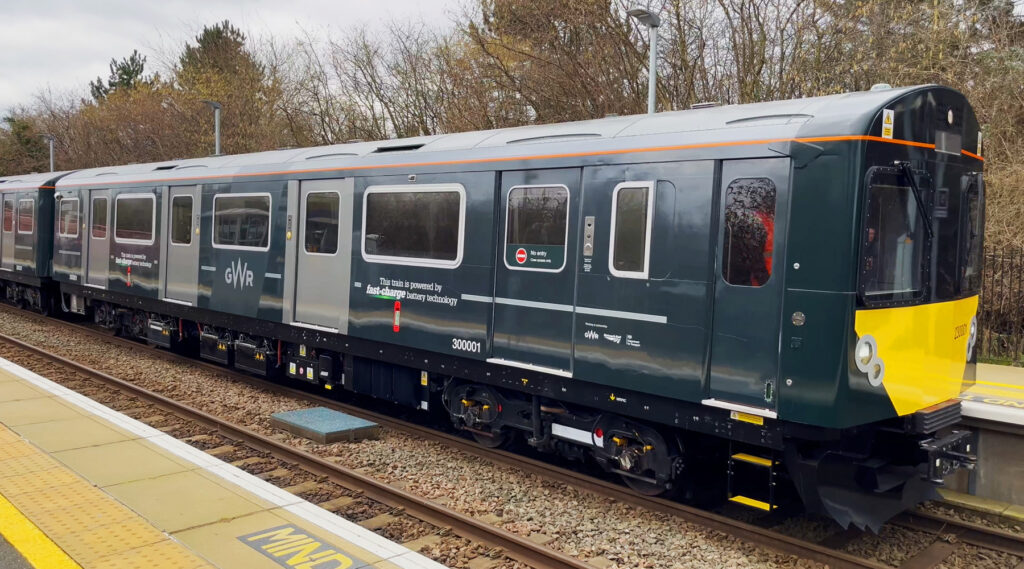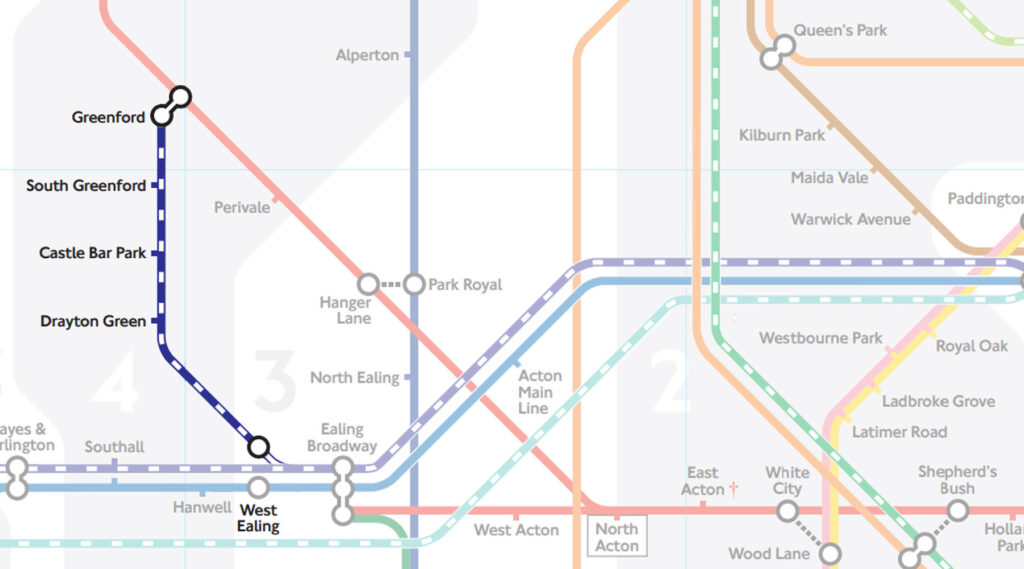Former District line tube trains* will start running in West London this Spring as GWR brings a converted ex-tube train to West Ealing for testing.
GWR announced plans two years ago to replace its diesel trains running the line between West Ealing and Greenford and signed a contract with Vivarail to trial new battery-charging technology on short branch line railways.
Vivarail had bought a fleet of old District line trains and was developing ways of converting them for mainline use on branch lines, powered by batteries instead of overhead wires. However, Vivarail entered administration in December 2022, but the project was saved when GWR agreed to buy the intellectual property, rolling stock and equipment relating to the FastCharge battery technology.
The FastCharge technology aims to solve the problem of delivering reliable, battery-only trains on branch lines, eliminating the use of diesel traction.
One of the main problems with battery powered trains was the time taken to recharge the batteries at the end of each trip along the branch line. To solve that, the FastCharge system can deliver charging power of up to 2,000kW – that’s eight times more powerful than Tesla’s Supercharger. At West Ealing, where the technology will be trialled for the first time this spring, the train will take just 3 ½ minutes to charge the batteries before restarting its journey on the Greenford branch line.
The use of batteries for extended operation has typically been constrained by their range and meant widespread implementation has, until now, not been possible. It also negates the need for overhead electric lines which are expensive and impact the landscape.
Unlike other charging technologies, the FastCharge system can be installed between the running rails in a few hours, with minimal disruption to the existing service or, in the case of West Ealing, no disruption at all.
It uses short charge rails that are fully covered by the train and live only when the train is charging. This is very different to third-rail systems where the rail is live all the time and is arguably a safer approach to take.
The train charges from the charge rails using retractable shoegear (electrical contact pads) fed by two track-side battery banks. These are continuously ‘trickle-charged’ from the grid with a 63 Amp connection akin to a domestic supply.
After more than 1,500 hours of testing at the Long Marston Rail Innovation Centre in Warwickshire, GWR’s Class 230 battery train began a series of test runs on the network earlier this week. The test runs will operate between Long Marston, Evesham, Honeybourne and Moreton-in-Marsh. Once completed, the train will be sent to GWR’s Reading Train Care Depot ahead of moving to West Ealing. Once the trial commences in west London, the battery train will run in non-passenger service alongside scheduled passenger services.
So, it’s something to keep an eye out for.
GWR Engineering Director Dr Simon Green said: “This work has never been done before and we’re leading the way to help the Department for Transport and Network Rail understand what is required to roll out this technology on the UK’s rail network.
“Only now has there been a combination of battery capability and charging technology that enables a branch line train to operate to the same timetable as a diesel unit, and yet still charge safely and with minimal impact on the local grid power supply.
“Clearly our specialist engineering team have been working round-the-clock to ensure that this FastCharge system has been fully tested and that there will be sufficient charge for the train to operate to the timetable on the Greenford branch line.”
GWR has already carried out simulations on other branch lines in the Thames Valley to explore how it could be rolled out even further in the future. It is hoped the technology could one day see battery-powered trains in operation across the UK’s approximately 2,000 miles of 80-plus branch lines.
*Yes, they’re not technically tube trains but sub-surface London Underground trains, but most people call them tube trains.









Hopefully if this is successful it can be rolled out to more lines, with the re-charging implemented at more stations. Being able to install the FastCharge system between the rails within a few hours presumably is a big advantage if it can avoid line closures.
It almost seems like you could have a spare “battery car” that was charged up and waiting to be switched over at the end of the line
That would take longer and cost more.
Not really necessary if the charge-up takes so little time.
I wonder whether the storage technology on-board the cars is mainly ultracaps with some longer cycle battery capacity behind them? Fast charging isn’t ideal for extended battery life, but is de rigeur for suoercaps/ultracaps.
This cap based technology is used on the street tramway (aka “light rail ” in Newcastle, Australia among other locations.
It just feels like anything will be contemplated rather than accepting reality and doing proper electrification of the rail network.
Agreed, but in the but absence of that, it’s better than nothing and will undoubtedly have useful spin-offs.
Why not use batteries? The technology is coming on leaps and bounds. Perhaps soon we may not need to do electrification everywhere so could avoid places that historically have stopped it. For example low tunnels and complex junctions.
This reminds me of the trams here in Luxembourg. Overhead wires outside the city centre, but in the city centre they charge the batteries at each station during the normal dwell-time; so about 30 seconds.
A more interesting line and route would be Trains going from Greenford via Acton main line on the Kensington Olympia to Waterloo.. There’s plenty of Platforms now.
It’s often said that full overhead electrification should be installed everywhere as the ‘final solution’ in getting moved over to green energy. The problem is that 25kV overhead wiring is horribly expensive, often involves major restructuring of bridges and other infrastructure, and also seems to take a massive amount of time in the UK, perhaps because of the ‘over-over’ engineering that we seem to require: consider, for example, the Transpennine Route Upgrade, which looks set to take five eternities to complete. If battery technology works, and I’m not entirely certain of that, it will be the saviour of many lesser-used railways. If it doesn’t, perhaps a modern variation of third-rail traction should now be considered…
A considered post. Hopefully battery tech has reached a point where its going to snowball, not a given though.